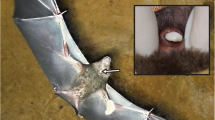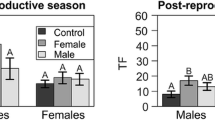Abstract
Combining chemical analysis and odour preference tests, we asked whether two closely related sympatric species of sac-winged bats use odour for species recognition. Males of the two sister species Saccopteryx bilineata and Saccopteryx leptura have pouches containing an odoriferous liquid in their antebrachial wing membrane, which is used in S. bilineata during courtship displays. Although both species occasionally share the same daytime roosts and are morphologically similar, there is no evidence for interbreeding. We compared the production and composition of the wing sac odorant in male S. leptura and S. bilineata and performed odour preference tests with female S. bilineata. Similar to male S. bilineata, male S. leptura cleansed and refilled their wing sacs with secretions, but they spent more time each day in doing so than male S. bilineata. Chemical analysis by gas chromatography and mass spectrometry revealed that male Saccopteryx carried species-specific scents in their wing sacs. Binary choice tests confirmed that female S. bilineata preferred the wing sac scents of male S. bilineata to those of the sister species, suggesting that the species specificity of male wing sac scents maintain the pre-mating isolation barrier between these closely related species.




Similar content being viewed by others
References
Albone ES (1984) Mammalian semiochemistry. Wiley, New York
Andersson M (1994) Sexual selection. Princeton University Press, Princeton, New Jersey
Apps PJ, Gordon DH, Viljoen HW, Pretorius V (1990) Chromatographic analysis of species specific odor profiles in Mastomys natalensis and M. coucha (Rodentia: muridae). J Chem Ecol 16:2667–2676
Bininda-Emonds ORP, Decker-Flum DM, Gittleman JL (2001) The utility of chemical signals as phylogenetic characters: an example from the Felidae. Biol J Linnean Soc 72:1–15. doi: 10.1006/bijl.2000.0492
Bloss J, Acree TE, Bloss JM, Hood WR, Kunz TH (2002) Potential use of chemical cues for colony-mate recognition in the big brown bat, Eptesicus fuscus. J Chem Ecol 28:819–833
Boake CRB, DeAngelis MP, Andreadis DK (1997) Is sexual selection and species recognition a continuum? Mating behavior of the stalk-eyed fly Drosophila heteroneura. PNAS 94:12442–12445
Bouchard S (2001) Sex discrimination and roostmate recognition by olfactory cues in the african bats Mops condylurus and Chaerephon pumilus. J Zool 254:109–117
Bradbury JW, Emmons L (1974) Social organisation of some Trinidad bats. I. Emballonuridae. Z Tierpsychol 36:137–183
Bradbury JW, Vehrencamp SL (1976) Social organization and foraging in emballonurid bats I. Field studies. Behav Ecol Sociobiol 1:337–381
Burger BV (2005) Mammalian semiochemicals. Top Curr Chem 240:231–278
Caspers B, Franke S, Voigt CC (2008) The wing sac odour of male greater sac-winged bats (Saccopteryx bilineata) as a composite trait: seasonal and individual differences. In: Hurst JL, Beynon RJ, Roberts SC, Wyatt TD (eds) Chemical signals in vertebrates XI. Springer, New York, pp 151–160
Caspers B, Wibbelt G, Voigt CC (2009) Histological examinations of facial glands in the greater sac-winged bat Saccopteryx bilineata (Chiroptera, Emballonuridae) and the potential use in territorial marking. Zoomorphology. doi:10.1007/s00435-008-0072-6
Clarke KR, Warwick RM (1994) Change in marine communities: an approach to statistical analysis and interpretation. Plymouth Marine Laboratory
Decker DM, Ringelberg D, White DC (1992) Lipid components in anal scent sacs of 3 mongoose species (Helogale-Parvula, Crossarchus-Obscurus, Suricata-suricatta). J Chem Ecol 18:1511–1524
De Fanis E, Jones G (1995) The role of odour in discrimination of conspecifics by pipstrelle bats. Anim Behav 49:835–839
Ganem G, Litel C, Menormand T (2008) Variation in mate preference across a house mouse hybrid zone. Heredity 100:594–601
Gustin MK, McCracken GF (1987) Scent recognition between females and pups in the bat Tadarida brasiliensis mexicana. Anim Behav 35:13–19
Heth G, Todrank J (2000) Individual odour similarities across species parallel phylogenetic relationships in the S. ehrenbergi superspecies of mole-rats. Anim Behav 60:789–795. doi:10.1006/anbe.2000.1538
Heth G, Nevo E, Todrank J (1996) Seasonal changes in urinary odors and in responses to them by blind subterranean mole rats. Physiol Behav 60:963–968
Heth G, Todrank J, Busquet N, Baudoin C (2003) Genetic relatedness assessment through individual odour similarities in mice. Biol J Linn Soc 78:95–603
Higgie M, Blows MW (2007) Are traits that experience reinforcement also under sexual selection? Am Nat 170:409–420. doi:10.1086/519401
Higgie M, Blows MW (2008) The evolution of reproductive character displacement conflicts with how sexual selection operates within a species. Evolution 62:1192–1203. doi:10.1111/j.1558-5646.2008.00357.x
Johansson BG, Jones TM (2007) The role of chemical communication in mate choice. Biol Rev 82:265–289. doi:10.1111/j1469-185X.200700009.x
Johnston RE, Derzie A, Chiang G, Jernigan P, Lee H-C (1993) Individual scent signatures in golden hamsters: evidence for specialization of function. Anim Behav 45:1061–1070
Kozak HL, Cirino LA, Ptacek MB (2008) Female mating preferences for male morphological traits used in species and mate recognition in the Mexican sailfin mollies, Poecilia velifera and Poecilia petenensis. Behav Ecol 19:463–474. doi:10.1093/beheco/arm139
Lim BK, Engstrom MD, Bickham JW, Patton JC (2007) Molecular phylogeny of New World sheath tailed bats (Emballonuridae:Diclidurini) based on loci from the four genetic transmission systems in mammals. Biol J Linnean Soc 93:189–209
Nevo E, Bodmer M, Heth G (1976) Olfactory discrimination as an isolating mechanism in speciating mole rats. Experientia 32:1511–1512
Penn D, Potts WK (1998) Chemical signals and parasite-mediated sexual selection. TREE 13:291–296
Pfennig KS (1998) The evolution of mate choice and the potential for conflict between species and mate-quality recognition. Proc R Soc Lond B 265:1743–1748
Rice WR, Gaines SD (1994) ‘Heads I win, tails you’: testing directional alternative hypotheses in ecological and evolutionary research. TREE 9:235–237
Ryan MJ, Rand AS (1993) Species recognition and sexual selection as a unitary problem in animal communication. Evolution 47:647–657
Safi K, Kerth G (2003) Secretions of the interaural gland contain information about individuality and colony membership in the Bechstein’s bat. Anim Behav 65:363–369. doi:10.1006/anbe.2003.2067
Scully WMR, Fenton MB, Saleuddin ASM (2000) A histological examination of the holding sacs and glandular scent organs of some bat species (Emballonuridae, Hipposideridae, Phyllostomidae, Vespertilionidae and Molossidae). Can J Zool 78:613–623
Starck D (1958) Beitrag zur Kenntnis der Armtaschen und anderer Hautdrüsenorgane von Saccopteryx bilineata Temminck 1838 (Chiroptera, Emballonuridae). Gegenbaurs Morphol Jahrb 99:3–25
Todrank J, Heth G (2003) Odor–genes covariance and genetic relatedness assessments: rethinking odor based “recognition” mechanisms in rodents. Adv Stud Behav 32:77–130
Voigt CC (2002) Individual variation of perfume blending in male sac-winged bats. Anim Behav 63:31–36
Voigt CC (2003) Sac-winged bats, sheath-tailed bats, and ghosts bats (Emballonuridae). Grizmek’s life encyclopedia: mammals II, vol 13 (edited by Kleiman DG, Geist V, Hutchins M, McDade MC). Gale Group, Farmington Hills, Michigan, pp 355–365
Voigt CC (2005) The evolution of perfume blending and wing sacs in emballonurid bats. In: Mason RT, LeMaster MP, Müller-Schwarze D (eds) Chemical signals in vertebrates X. Springer, New York, pp 93–100
Voigt CC, Schwarzenberger F (2008) Female reproductive endocrinology of a small tropical bat (Saccopteryx bilineata; Emballonuridae) monitored by fecal hormone metabolites. J Mammal 89:50–57
Voigt CC, von Helversen O (1999) Storage and display of odor in male Saccopteryx bilineata Emballonuridea. Behav Ecol Sociobiol 47:29–40
Voigt CC, Caspers B, Speck S (2005) Bats, bacteria, and bat smell: sex-specific diversity of microbes in a sexually selected scent organ. J Mammal 86:745–749
Voigt CC, Streich JW, Dehnhard M (2007) Assessment of fecal testosterone metabolite analysis in free ranging Saccopteryx bilineata (Chiroptera; Emballonuridae). Acta Chiropt 9:463–476
Voigt CC, Behr O, Caspers B, Helversen von O, Knörnschild M, Mayer F, Nagy M (2008) Songs, scents, and senses: sexual selection in the greater sac-winged bat, Saccopteryx bilineata. J Mammal 89:1401–1410
Welsh CJ, Moore RE, Bartelt RJ, Jackson LL (1988) Novel, species-typical esters from preputial glands of sympatric voles, Microtus montanus and M. pennsylvanicus. J Chem Ecol 14:143–158
Zhang J-X, Sun L, Zhang Z-B, Wang Z-W, Chen Y, Wang R (2002) Volatile compounds in anal gland of Sibirian weasels (Mustela sibirica) and steppe polecats (M. eversmanni). J Chem Ecol 28:1287–1297
Zhang J-X, Ni J, Ren X-J, Sun L, Zhang Z-B, Wang Z-W (2003) Possible coding for recognition of sexes, individuals and species in anal gland volatiles of Mustela eversmanni and M. sibirica. Chem Senses 28:381–388
Acknowledgements
We thank the Costa Rican Authorities (MINAE) and especially Javier Guevara for research and collecting permits. We are also thankful to Maike Dieckmann who helped in the field. Dina Dechmann, Nicole Burgener, Detlev Kelm, Tomer Czaczkesmi, and two anonymous referees gave helpful comments on earlier versions of the manuscript. The study was financed by a grant from the Deutsche Forschungsgemeinschaft (DFG) to Christian C. Voigt (VO890/3 and VO890/7) and a grant from the Berliner Chancengleichheitsprogramm to Barbara Caspers. We declare that the experiments complied with the current laws of Costa Rica.
Author information
Authors and Affiliations
Corresponding author
Additional information
Communicated by P. Kappeler
Rights and permissions
About this article
Cite this article
Caspers, B.A., Schroeder, F.C., Franke, S. et al. Odour-based species recognition in two sympatric species of sac-winged bats (Saccopteryx bilineata, S. leptura): combining chemical analyses, behavioural observations and odour preference tests. Behav Ecol Sociobiol 63, 741–749 (2009). https://doi.org/10.1007/s00265-009-0708-7
Received:
Revised:
Accepted:
Published:
Issue Date:
DOI: https://doi.org/10.1007/s00265-009-0708-7




